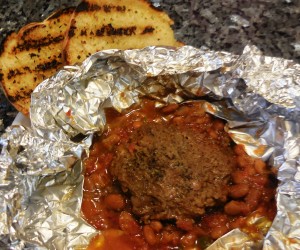Campfire cuisine: Foil packs are the building blocks of outdoor eating
The potential dishes one can make on a campfire is literally endless. We’ve already discussed some success stories with a simple campfire breakfast, eclairs and pizza.
But perhaps we should take a cue from Julie Andrews in “The Sound of Music.” Let’s start at the very beginning — it is, they say, a very good place to start.
When it comes to creating a meal over a campfire, you can’t go wrong with foil pack cooking. It is easy, efficient, extremely tasty — and variations are limited only by one’s imagination.
Growing up in the Boy Scout organization, foil packs — or what some people call foil babies — were the first open-fire meal I ever tried making. The concept is very, very simple.
You take various ingredients, pile them up on a sheet of foil, carefully fold the foil into an air-tight pouch and cook in/on your campfire. It all starts, as usual, with the perfect campfire.
The most basic of foil pack meals consists of a meat, some veggies and a few seasonings, and it is suggested you try a few simple foil pack meals before getting into the more gourmet varieties.
Start by getting the various ingredients ready. I suggest starting with some ground beef or sausage. In a recent meal, we used about a quarter or third pound of meat in each foil pack. Meat options are nearly endless and you could easily substitute in some chicken (although this may burn easier than the greasier hamburg or sausage options), tuna, shrimp or other protein.
While I prepared the meat and spread it evenly on each of four sheets of aluminum foil, my wife cut up a pile of potatoes, carrots, onions and green peppers. Again, the options here are many, and you could prepare a pile of mushrooms, broccoli, cauliflower, tomatoes, etc. Also, when cutting these items, remember that the bigger the pieces, the longer it will take to thoroughly cook through. You want small, even sized pieces to make the meal go as event-free as possible.
On a sheet of aluminum foil, place your desired amount of meat. Crumble up the meat so it isn’t in one big ball — this helps the cooking process go quicker, food to be cooked more thoroughly and flavor to spread evenly. Then you can get the kids involved by allowing them to pick out the vegetables and other ingredients they’d like to add. Some may want more potatoes and carrots and less of something else. This is a great way to empower the kids to help in the cooking process.
Finally, you can season the meal by adding salt, pepper, garlic, oregano, etc. Some extra flavoring can come in the form of ketchup, mustard, barbecue sauce, A1 or other steak sauce, Worcestire sauce, soy sauce, advocado or whatever your heart fancies.
The key to all this is how you fold the foil pack. I usually start by pulling up two of the sides and rolling them tightly down together until it comes in contact with the food inside. If your food fills the foil too much, you can put a second piece of foil on top and tightly roll up each side. The end result should be a package as air-tight as possible, creating a cooking packet that almost acts like a pressure cooker that heats thoroughly.
Once your foil pack is carefully folded, you can cook it over a prepared bed of coals either on a rack or even directly in the coals themselves. It is recommended that if you are cooking on extremely hot coals that you use heavier duty foil and keep turning/adjusting the package to reduce the change the foil burns or melts through. The best scenario is to use a rack or keep the foil pack suspended above the fire at least a few inches to allow more control in heating.
Regardless of where you place the pack, it is advised you turn it regularly to help ensure even cooking. The pack itself, if folded properly and no holes are accidently poked through during the turning process, will puff up when the food is cooking well.
When checking your food, be sure the meat is thoroughly cooked through and veggies are as tender as desired before digging in. You may have to repack in a new sheet of foil if not cooked to perfection the first time around. Foil packs can burn if left untended too long.
Have you tried cooking with foil packs? Have any success stories to share? Have any special concoctions that really turn out tasty? We’d love to hear about them.



